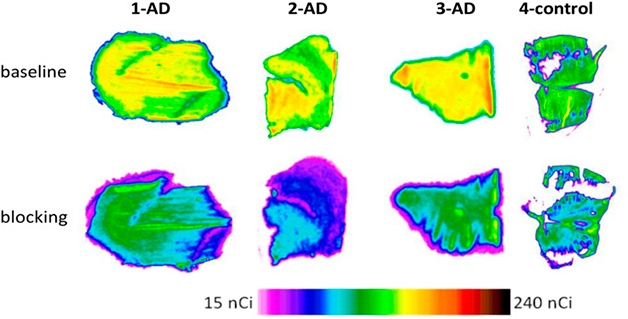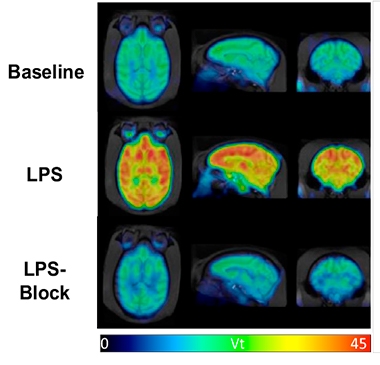New PET Tracer Selectively Lights Up Activated Microglia in Brain
Quick Links
Researchers would like better ways to image inflammation in the brain. Currently, some use PET tracers targeting the mitochondrial transporter TSPO to measure active microglia, but these ligands are plagued by poor specificity and high variability. In the January 7 Proceedings of the National Academy of Sciences of the United States, online, researchers led by Andrew Horti and Martin Pomper at the Johns Hopkins University School of Medicine in Baltimore present a new tracer candidate that binds colony stimulating factor 1 receptor (CSF1R). In the brain, CSF1R is found only on microglia and infiltrating macrophages. In animal models, the ligand, CPPC, had bound poorly in healthy brain, but this doubled under inflammatory conditions. Likewise, binding in postmortem AD brain was about twice that of healthy tissue. Tracer uptake could be completely blocked by pretreating with other CSF1R ligands, demonstrating high specificity. “This is the first tool to look specifically at the microglial component of neuroinflammation in vivo,” Pomper told Alzforum. He said the next step will be to test CPPC in clinical trials.
- Researchers debut a new PET tracer that binds specifically to activated microglia.
- In animal models, uptake in inflamed brain was twice that of healthy brain.
- Ditto in postmortem AD brain; human trials are being planned.
Other researchers said the tracer shows potential. “This is a welcome and potentially important advance,” Hugh Perry at the University of Southampton, U.K., wrote to Alzforum. Andreas Jacobs at Westfälische Wilhelms-Universität, Münster, Germany, agreed, “The new radiotracer should be of highest interest for researchers working in the field of molecular imaging of microglia in various neurological disease conditions.”
For decades, the standard microglial tracer has been PK11195, which binds TSPO, but with poor specificity and a weak signal-to-noise ratio. This has led to an effort to develop better TSPO ligands (Mar 2013 conference news; Dec 2014 conference news). Meanwhile, other researchers contend that TSPO is not an ideal target, as it can also be present in activated astrocytes and endothelial cells. In addition, a polymorphism in the human TSPO gene leads to low ligand binding in some people (Apr 2012 news; Feb 2015 news).

New Way to Image Neuroinflammation? A new PET tracer, CPPC, binds to three postmortem AD brains but not to control (top row); uptake is completely blocked by unlabeled tracer (bottom). [Courtesy of Horti et al., PNAS.]
To find a more specific tracer, Horti, Pomper, and colleagues turned to CSF1R, which is upregulated during inflammation and in AD mouse models (Walker et al., 2017; Murphy et al., 2000). They started with a CSF1R inhibitor, 5-cyano-N-(4-(4-methylpiperazin-1-yl)-2-(piperidin-1-yl)phenyl)furan-2-carboxamide, developed by Johnson & Johnson as an anti-inflammatory agent (Illig et al., 2008). They radiolabeled CPPC with carbon 11 and tested it in wild-type mice, where it had good brain uptake. When they induced neuroinflammation by injecting lipopolysaccharide into one hemisphere, binding went up by 50 percent. Signal rose even higher in a baboon, where uptake more than doubled after LPS injection. Pretreating the animal with cold CPPC abolished binding, demonstrating specificity (see image below).

Strong and Specific Binding. In a baboon, tracer binding spikes during neuroinflammation (middle), but is completely blocked by pretreatment with cold ligand (bottom). [Courtesy of Horti et al., PNAS.]
Other disease models also showed strong CPPC uptake. In a mouse expressing human APP with the Swedish and Indiana mutations, [11C]CPPC uptake was up 31 percent in frontal cortex compared with wild-type mice (Melnikova et al., 2013). By contrast, in an experimental autoimmune encephalomyelitis mouse, tracer uptake doubled in the brainstem, where most demyelination occurs. In postmortem human brains, AD tissue had about twice as much signal as healthy brain. Again, binding could be blocked by unlabeled CPPC, as well as by three other CSF1R inhibitors (see image at top). Pomper noted that the signal was at least as strong as that seen with TSPO, even though the tracer binds a more select cell set.
Other researchers wanted to see more data on the tracer’s binding affinity and sensitivity, as well as detailed cellular-level staining proving that it binds specifically to microglia. Agneta Nordberg at the Karolinska Institute in Solna, Sweden, wondered whether the tracer would detect all activated microglial subtypes, including those present early in Alzheimer’s disease (Edison et al., 2018; Jun 2017 news; Dec 2018 news). “It is somewhat difficult to judge its clinical value for AD patients,” Nordberg wrote (full comment below).
Pomper plans to investigate that next. Toxicology studies have demonstrated the tracer is safe for human use. Pomper will scan people with various inflammatory brain disorders such as AD, multiple sclerosis, and traumatic brain injury to see how it performs. Meanwhile, Horti is developing an analog that can be labeled with fluorine 18. With a longer half-life, this version could be commercialized and see more widespread use in the clinic. Eventually, CPPC could be used not just to image neuroinflammation, but to measure target engagement of anti-inflammatory drugs that inhibit CSF1R, Pomper suggested. “We could measure drug occupancy in individual patients and use that to tailor therapies to each person,” he told Alzforum.—Madolyn Bowman Rogers
References
News Citations
- Glial Imaging—Amid Slow Progress, EU Project Takes Up Challenge
- Meet GE180: A PET Ligand for Tracking Neuroinflammation?
- Imaging Inflammation: Can Glial PET Tracers Make a Mark?
- Structure of Microglial Receptor Offers Clues for PET Ligand Design
- Hot DAM: Specific Microglia Engulf Plaques
- Microglia Reveal Formidable Complexity, Deep Culpability in AD
Paper Citations
- Walker DG, Tang TM, Lue LF. Studies on Colony Stimulating Factor Receptor-1 and Ligands Colony Stimulating Factor-1 and Interleukin-34 in Alzheimer's Disease Brains and Human Microglia. Front Aging Neurosci. 2017;9:244. Epub 2017 Aug 9 PubMed.
- Murphy GM Jr, Zhao F, Yang L, Cordell B. Expression of macrophage colony-stimulating factor receptor is increased in the AbetaPP(V717F) transgenic mouse model of Alzheimer's disease. Am J Pathol. 2000 Sep;157(3):895-904. PubMed.
- Illig CR, Chen J, Wall MJ, Wilson KJ, Ballentine SK, Rudolph MJ, DesJarlais RL, Chen Y, Schubert C, Petrounia I, Crysler CS, Molloy CJ, Chaikin MA, Manthey CL, Player MR, Tomczuk BE, Meegalla SK. Discovery of novel FMS kinase inhibitors as anti-inflammatory agents. Bioorg Med Chem Lett. 2008 Mar 1;18(5):1642-8. Epub 2008 Jan 19 PubMed.
- Melnikova T, Fromholt S, Kim H, Lee D, Xu G, Price A, Moore BD, Golde TE, Felsenstein KM, Savonenko A, Borchelt DR. Reversible pathologic and cognitive phenotypes in an inducible model of Alzheimer-amyloidosis. J Neurosci. 2013 Feb 27;33(9):3765-79. PubMed.
- Edison P, Donat CK, Sastre M. In vivo Imaging of Glial Activation in Alzheimer's Disease. Front Neurol. 2018;9:625. Epub 2018 Aug 7 PubMed.
Further Reading
Primary Papers
- Horti AG, Naik R, Foss CA, Minn I, Misheneva V, Du Y, Wang Y, Mathews WB, Wu Y, Hall A, LaCourse C, Ahn HH, Nam H, Lesniak WG, Valentine H, Pletnikova O, Troncoso JC, Smith MD, Calabresi PA, Savonenko AV, Dannals RF, Pletnikov MV, Pomper MG. PET imaging of microglia by targeting macrophage colony-stimulating factor 1 receptor (CSF1R). Proc Natl Acad Sci U S A. 2019 Jan 29;116(5):1686-1691. Epub 2019 Jan 11 PubMed.
Annotate
To make an annotation you must Login or Register.

Comments
Karolinska Institutet
This is an interesting paper describing the development of a new microglia PET tracer that binds to the CSF1 receptor. Several experimental models have been tested in vitro and in vivo in the paper showing a good binding that can be blocked. Many questions can be raised regarding its relevance for Alzheimer’s disease. What is the binding affinity in postmortem AD brain tissue? Maximum binding load? Regional brain distribution? What is the correlation or the binding with immunohistochemistry using different antibodies for microglia?
PET studies of microglia are especially of interest in early stages of AD disease as well as in other non-AD dementia disorders. Is this PET tracer expected to detect microglia subtypes present early in the course of disease? I assume the histopathological studies have shown a number of microglia subtypes in human brain. Some recent PET studies with TPSO microglia tracers suggest a biphasic change in microglia at different stages of AD (Fan et al., 2017). This CSF1R microglia PET tracer might be promising, but it is somewhat difficult to judge its clinical value for AD patients.
References:
Fan Z, Brooks DJ, Okello A, Edison P. An early and late peak in microglial activation in Alzheimer's disease trajectory. Brain. 2017 Mar 1;140(3):792-803. PubMed.
University College London
There is indeed a real need for tools to image neuroinflammation in the human brain. This neuroinflammatory response is dominated by an innate immune response by cells of the myeloid lineage: thus new PET ligands to identify macrophages and microglia in the CNS in vivo is important.
The current PET ligands, especially to TSPO, have well-known limitations including binding to other cell types beyond microglia (e.g., astrocytes and endothelial cells).
The use of a ligand that binds a receptor exclusively expressed on macrophages and microglia, CSF1R, is a welcome and potentially important advance. However to avoid the limitations that have bedeviled TSPO ligands it would have been useful to demonstrate at a cellular level using autoradiography that [3H]CPPC only binds microglia and perivascular macrophages in brain parenchyma.
The differential signal reported across the different brain regions is relatively small despite the fact that the microglia density varies considerably between cerebellum and cortex/hippocampus. Similarly, depletion of the microglia and studies in several disease models also report rather modest changes in binding. Studies to determine whether the sensitivity will be sufficient for clinical studies to detect early changes in human pathology will be eagerly awaited.
Make a Comment
To make a comment you must login or register.